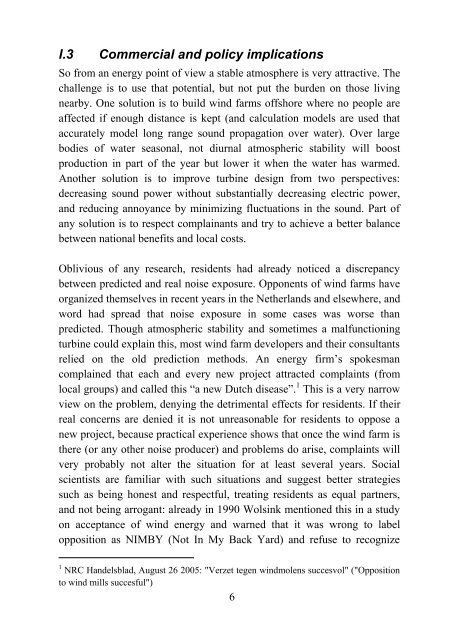The sounds of high winds
The sounds of high winds
The sounds of high winds
You also want an ePaper? Increase the reach of your titles
YUMPU automatically turns print PDFs into web optimized ePapers that Google loves.
I.3 Commercial and policy implications<br />
So from an energy point <strong>of</strong> view a stable atmosphere is very attractive. <strong>The</strong><br />
challenge is to use that potential, but not put the burden on those living<br />
nearby. One solution is to build wind farms <strong>of</strong>fshore where no people are<br />
affected if enough distance is kept (and calculation models are used that<br />
accurately model long range sound propagation over water). Over large<br />
bodies <strong>of</strong> water seasonal, not diurnal atmospheric stability will boost<br />
production in part <strong>of</strong> the year but lower it when the water has warmed.<br />
Another solution is to improve turbine design from two perspectives:<br />
decreasing sound power without substantially decreasing electric power,<br />
and reducing annoyance by minimizing fluctuations in the sound. Part <strong>of</strong><br />
any solution is to respect complainants and try to achieve a better balance<br />
between national benefits and local costs.<br />
Oblivious <strong>of</strong> any research, residents had already noticed a discrepancy<br />
between predicted and real noise exposure. Opponents <strong>of</strong> wind farms have<br />
organized themselves in recent years in the Netherlands and elsewhere, and<br />
word had spread that noise exposure in some cases was worse than<br />
predicted. Though atmospheric stability and sometimes a malfunctioning<br />
turbine could explain this, most wind farm developers and their consultants<br />
relied on the old prediction methods. An energy firm’s spokesman<br />
complained that each and every new project attracted complaints (from<br />
local groups) and called this “a new Dutch disease”. 1 This is a very narrow<br />
view on the problem, denying the detrimental effects for residents. If their<br />
real concerns are denied it is not unreasonable for residents to oppose a<br />
new project, because practical experience shows that once the wind farm is<br />
there (or any other noise producer) and problems do arise, complaints will<br />
very probably not alter the situation for at least several years. Social<br />
scientists are familiar with such situations and suggest better strategies<br />
such as being honest and respectful, treating residents as equal partners,<br />
and not being arrogant: already in 1990 Wolsink mentioned this in a study<br />
on acceptance <strong>of</strong> wind energy and warned that it was wrong to label<br />
opposition as NIMBY (Not In My Back Yard) and refuse to recognize<br />
1 NRC Handelsblad, August 26 2005: "Verzet tegen windmolens succesvol" ("Opposition<br />
to wind mills succesful")<br />
6
















